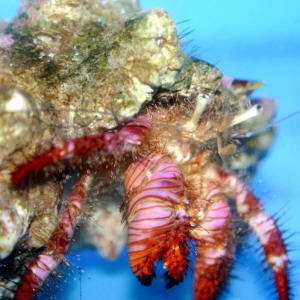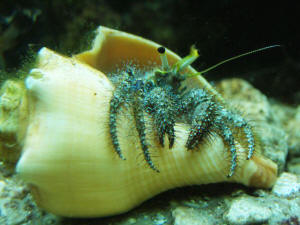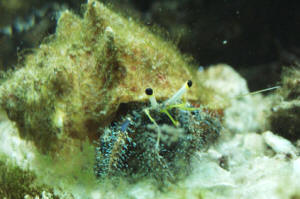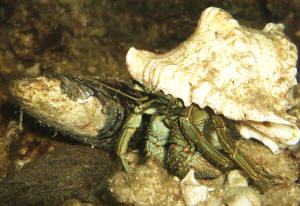|
FAQs about Hermit Crabs: Petrochirus
diogenes and other Giant Hermits
Related Articles: Hermit
Crabs, Crabs, Marine Scavengers, Fresh to
Brackish Crabs,
Related FAQs: Hermits 1,
Hermit Crabs 2, Hermit Crabs 3, Hermit ID, Hermit Behavior, Hermit Compatibility, Hermit Selection, Hermit Systems, Hermit Feeding, Hermit Reproduction, Hermit Disease/Health, Land Hermit Crabs, Squat Lobsters, Micro-Crustaceans, Amphipods, Copepods, Mysids, Hermit
Crabs, Shrimps,
Cleaner
Shrimps, Banded Coral
Shrimp, Mantis
Shrimp, Anemone
Eating Shrimp, Marine Scavengers, Crustacean Identification, Crustacean Selection, Crustacean Behavior, Crustacean Compatibility, Crustacean Systems, Crustacean Feeding, Crustacean Disease, Crustacean Reproduction,
FAQs: By species: Calcinus laevimanus (Zebra, Left-handed
Hermit), Clibanarius tricolor
(Blue-Legs), Clibanarius vittatus (a
common Gulf of Mexico hermit crab), Dardanus megistos
(Shell-Breaking Reef, White-spot, Fuzzy
Leg Hermit Crab), Paguristes cadenati (Scarlet, Red-Legged),
& Anemone
Hermits, Sponge/Staghorn/Coral
house Hermits, Unknown/Wild-collected,
|

|
Feeding large hermit crab
5/28/14
Hello! Thank you for being such a great knowledge resource! I have a
hermit crab question for you. I recently acquired a rather large
Dardanus pedunculatus with an almost equally large Calliactis anemone.
<Yikes!>
Yes, I did research before purchasing but am finding that there are some
gaps in the information I was able to find. So, I know what to feed the
hermit crab and the anemone, and also know that the anemone needs
frequent feeding.
<Mmm; not "that" frequent... once, twice a week is fine... less if
there's "food about" in the system... messiness from the Hermit...>
What I am having difficulty with is judging how much and how often to
feed the crab.
<You can gauge this by close observation of the Anemones... they'll
shrink and expand correspondingly>
Overfeeding would definitely be bad but so would underfeeding.
<Not so much the latter; not to worry... can go sans purposeful feeding
for months>
The crab/anemone pair are the sole residents of a species tank,
and the combined size of the hermit crab plus shell are nearly the size
of my fist.
<Double YIKES!>
What size "portions" should be fed, and at what frequency?
<Well... does depend... mainly on water temperature; availability of
local-produced food organisms (there can be quite a bit in sand and
on/in hard substrates period)... but something the size of the last
digit of your pinkie finger once/twice a week is about right>
It's pretty easy to measure food amounts for this guy, as he is more
than willing to take food directly from forceps.
<Ah yes>
Thanks in advance for your help,
Joanne
<And you for sharing. Bob Fenner>
Re: Feeding
large hermit crab 5/30/14
Thank you so much! I feel much more comfortable now about taking care of
this big guy. You're absolutely right, overfeeding is much more
dangerous than underfeeding. But in the longer term, chronic
underfeeding would be just plain cruel. If we take these creatures out
of the ocean, the least we can do is make sure we give them good care,
don't you think?
<Oh yes>
As a sort of side question, has anyone done any research into crab
intelligence?
<Have seen a few such studies... am sure there are many. BTW, hermits
are not decapods (true crabs)... but anomurans>
My hermit crab has learned very quickly that I am not a threat to him
and readily takes food from the forceps (I'm afraid to use my bare
fingers with this crab!)
<As you should be... Very pinchy!>
But is that a sign of intelligence, or is it just a sign of becoming
accustomed to a particular stimulus?
<I don't know how I'd go about differentiating>
For example, the Calliactis anemone is much slower to close up now that
it is well acclimated but you can hardly argue that it is intelligent!
<A matter of degree to my thinking... the universe is far less
"discrete" than what many humans, particularly westerners, have been
conditioned to believe... Such matters are more/less, not yes/no>
Cheers,
Joanne
<And you, BobF>
Hairy Yellow Hermit Crab, Aniculus Maximus,
Dardanus megistos 11/13/10
Hello,
<Hi there>
I have been all round the internet and reading my assorted crustacean
books and have not been able to find anything but ominous warnings
about keeping Aniculus Maximus in a tank. I have a 55 gallon tank with
two coral banded shrimp and a two claw cave shrimp. I have a low lying
rock work a 4 inch sand bed a wet dry trickle filter and the necessary
aeration equipment. My step father is a big diver and occasionally
offers me Aniculus Maximus and I have a excellent LFS that specializes
in marine live stock within a reasonable distance of my home that on
occasion stocks these guys. Would it be feasible to keep Aniculus
Maximus in my current set up and if not Dardanus megistos?
<Both these hermits are very opportunistic omnivores... if either
can "catch" the shrimps, they will be consumed. Bob
Fenner>
Thanks in advance!
Jacob
Re: Hairy Yellow Hermit Crab, Aniculus Maximus, Dardanus Megistos
11/14/10
Thanks so much! I have a smaller tank I could move my CBS and two claw
cave shrimp to so I think if I do purchase a Aniculus Maximus or
Dardanus Megistos that will most likely be the course of action.
Cheers
Jacob
<These are really neat animals... BobF>
|
Who's that crab? Anomuran IDs... for what?
9/30/09
You guys are always helpful, and awesome!
So, I figured I'd give it a try to see if you could help me
figure out what kind of LARGE crab this is. We got him about four
years ago from PetCo. Of course, labeled "hermit crab -
Saltwater" and after asking them about him, they were as
helpful as expected....which is to say not at all and called him
a general hermit crab that sometimes but rarely came in
shipment.
<... then... why did you buy it?>
Anyway, the aptly named "Blue Crab" lived happily for a
while but due to some unfortunate accident, he died. We've
been looking for another one ever since! He was about 2.5-3
inches in size. Blue, with white eye stalks with yellow tips, and
black eyeballs. Yellow antennae, and white fuzz on his blue legs
and claws. (See photo if I attached properly.)
<... Looks to be a Dardanus lagopodes... 'cept for the
body colour. This species is usually maroon/reddish...>
As a bonus, we also used to have a very LARGE hermit crab (Gomez)
who was dark pinto green, with thin red/brown accents. Smooth,
not fuzzy, with thick, but not giant claws. This guy got
about3.5-4 inches before he died. We don't know what kind of
hermit he was either! We've asked fish dealers and hobbyists,
and pet stores and no one seems to know anything much about large
hermits, except for the most popular kind.
Please help...and thank you! : )
Melissa & Kevin
<... will ask LynnZ if she can run down for you. Bob
Fenner>
|
 
 |
|
Re: Who's that crab? Anomuran IDs... for what?
9/30/09
<Hello, Melissa and Kevin - Lynn here this afternoon.>
You guys are always helpful, and awesome!
<On behalf of Bob and crew, I thank you!>
So, I figured I'd give it a try to see if you could help me
figure out what kind of LARGE crab this is. We got him about four
years ago from PetCo. Of course, labeled "hermit crab -
Saltwater"
<Yep, that sort of generality is cause to run to your trusty
research book or internet site(s) before buying, to make sure the
animal will be a good/safe addition for your system.>
..and after asking them about him, they were as helpful as
expected....which is to say not at all and called him a general
hermit crab that sometimes but rarely came in shipment.
<I'd love to know where those shipments were from!>
Anyway, the aptly named "Blue Crab" lived happily for a
while but due to some unfortunate accident, he died. We've
been looking for another one ever since!
<I'd keep checking Petco, in hopes that they're still
getting shipments from the same area. Perhaps another such hermit
will show up.>
He was about 2.5-3 inches in size. Blue, with white eye stalks
with yellow tips, and black eyeballs. Yellow antennae, and white
fuzz on his blue legs and claws. (See photo if I attached
properly.)
<Very pretty! I've looked all over, but the closest I can
get to an ID is what Bob already mentioned, Dardanus lagopodes.
Usually, these hermits are a mottled maroon/red/brown and white,
but I've read reports of color variants. Perhaps this is one.
If you wish to look further I'd recommend trying a few
internet image search engines (Google, Bing, etc.) using the
genus name: Dardanus.>
As a bonus, we also used to have a very LARGE hermit crab (Gomez)
who was dark pinto green, with thin red/brown accents. Smooth,
not fuzzy, with thick, but not giant claws. This guy got about
3.5-4 inches before he died. We don't know what kind of
hermit he was either!
<I'm sorry to say that I don't either. I can't
quite see enough detail to be of much assistance. For instance,
are the claws of equal in size, or different? Hermits in the
family Diogenidae tend to have a larger left claw relative to the
right, while those in Paguridae tend to have a larger right claw
than left. If you remember, or have other photos that show this,
perhaps you could search according to family, then narrow things
from there.>
We've asked fish dealers and hobbyists, and pet stores and no
one seems to know anything much about large hermits, except for
the most popular kind.
<Well, there are a lot of them out there!>
Please help...and thank you! : )
<You're very welcome, and good luck in your
search!>
Melissa & Kevin
<Take care, LynnZ>
Re: Who's that crab? Anomuran IDs... for what?
9/30/09
<Hello again!>
Thank you so much!
<You're very welcome!
The green crab had claws that were the same size, as did the blue
crab!
<Gotcha>
Maybe if they had gotten bigger or older it would have varied
where one was bigger?
<Well, the difference in claw sizes related to family is
something that can help with an ID but it's not a guarantee.
That's why I was careful to use the phrase 'tend to'
instead of 'always'. The differences could be slight or
not at all and on top of that, there could be other factors at
play.>
Probably not, but they were super crabs. We really miss them!
<I can certainly understand that!>
Thanks again for the help.
<It was a pleasure.>
We'll keep searching!!
<Please do! If/when you do find another, please send more
photos and we'll see if we can't figure out what
you've got. Take care, LynnZ>
Follow-up: Re: Re: Who's that crab? Anomuran
IDs... for what? 10/1/09
<Hi Melissa!>
With your and Bob's help for a start on the Latin name, we
found this French site:
http://users.skynet.be/fa311324/article/hermit.htm
<Ah yes, you found one of my favorites. It's loaded with
wonderful photos. Here's another site as well:
http://www.deepseaimages.com/dsilibrary/showgallery.php?cat=675
See families Diogenidae and Paguridae, starting about halfway
down the page:
http://www.roboastra.com/hastherm/hpherm.html>
..(Also, at the bottom there is "Phimochirus holthuisi"
which says Photo credit Bob Fenner. Thought that was cute! :
)
<Yes indeed, another wonderful photo!>
But about halfway down it shows "Dardanus lagopodes"
which is a tiny bit more red but has the exact same eye stalks
and yellow antennae as our long lost blue crab.
<I know the photo and yes, it is indeed very similar. Here are
several others as well:
http://www.deepseaimages.com/dsilibrary/showphoto.php?photo=7001&cat=675
http://cookislands.bishopmuseum.org/species.asp?id=7270 >
So, I'd guess we would have to agree with you guys on what he
was!
<It does indeed appear to be either a color variant or another
species in that genus.>
He was such a vibrant blue though...I wish we could have kept him
alive!
<Indeed. I found an interesting parallel on the 'net last
night after my last response. It deals with what appears to be a
blue specimen of Pagurus bernhardus found off the coast of
England. See this link: http://www.glaucus.org.uk/Torped56.html.
It's postulated that the color might be due to a parasite. I
honestly don't know if that's possible or not. Have you
ever seen a blue lobster? The beautiful color is apparently due
to a genetic defect that can be described at the following link.
It may be more than you ever wanted to know on the subject, but
it's interesting!
http://srs.dl.ac.uk/Annual_Reports/AnRep01_02/pdf/08_09%20Crustacyanin.pdf
>
We were soooo new to the hobby back then, and for some reason got
something in our tank that killed all of our crustaceans, even
the copepods.
<Aggressive hermits can do a number on their crustacean
relatives, snails, and even fishes if they can grab, or catch
them sleeping. As for the copepods, they may well have been
reduced by various fishes you had at the time.>
Fish were fine..who knows!
<They may well have either steered clear of the hermits or
slept out of reach of them!>
It's just been trial and error after trial and error for
us!
<Yep, in this hobby you find out pretty quickly that research
is your friend! That is, research *before* bringing home!>
Everything is healthy and thriving now and has been for a few
years.
<Good to hear. I'm wondering if there isn't a parallel
between this and the lack of large hermits!>
Anyway, I think it might be the same species. Obviously there are
more sites out there that show a crab that looks like him, like
this: http://www.zipcodezoo.com/hp350/Dardanus_lagopodes_0.jpg
But I've still yet to find one that's blue!
<Same here!>
Anyway, the PetCo in our area stopped carrying saltwater
animals...and I actually think that's really good because
they were always so sad, dying, or badly taken care of.
<That's frustratingly sad to see. I've seen both ends
of the spectrum in our area. It just depends on who's in
charge/running the section.>
Still not sure on the green crab. He grew pretty fast and so I
expect he would have gotten larger. That French site has two
photos of crabs labeled "Clibanarius sp"...which I
assume means "Clibanarius species of some sort"
*lol*
<That's exactly what it means!>
He was really olive green but the markings on these crabs look
similar, and his claws were about the same size as these look to
be (of course like you said they are probably slightly different,
but at a glance they look about the same size). Okay, anyway,
thank you again so much!
<You're very welcome! It's been a learning experience
for me as well and I appreciate it!>
I've been meaning to ask for years and just never got around
to it.
<I'm glad you got around to it. If I ever run into a blue
hermit like yours, I'll be sure to let you know.>
You've been really sweet and helpful...Have a great week!! :
)
<It was my pleasure. You have a great week as well!>
Melissa
<Take care, LynnZ>
|
| Elegant Hermit Crab, coral abrasion
4/19/08 Hello Guys, <Scott> I just bought a beautiful
hermit crab which I believe to be Aniculus elegans, the elegant
hermit crab. This ID is based solely on looking at photos on the
web and noting that most, but not all, of the sites identify him
thusly. A few think he is a Hairy Hermit Crab, Dardanus Sp.,
including my LFS where I bought it, That Fish Place. The crab's
colors match EXACTLY the pink and maroon coralline algae on its
shell, and the tips of his hairs are turquoise. The crab is very
beefy, i.e., all the outside legs are thick and strong looking,
which doesn't come through at all on any photo I have seen. My
questions: 1. Is he Aniculus elegans; or can you point me to some
web resource that will help me identify him - that does not appear
when you google "Aniculus elegans" OR ("A.
elegans" AND Aniculus)? <I do think this ID is correct>
2. How often should I give him some fish or chicken? <No
chicken... too fatty, hard to digest...> I am concerned that he
is not getting enough food (due to his exoskeleton, I cannot see if
he is skinny). He is rather lethargic compared to all my other
hermit crabs (three thin striped plus lots of reef janitors). He
grabs and eats VERY sloppily the fish and chicken I give him, but I
would expect him to be scouring my rocks looking for coral. <I
would offer this animal aquatic-based proteinaceous food purposely
2-3 times a week. Maybe via tongs...> From the book, *Life and
Death of Coral Reefs* Edited by Charles Birkeland, chapter 4,
*Bioerosion and Coral-Reef Growth: A Dynamic Balance*, by Peter W.
Glynn, Page 79: Two species of hermit crabs that feed on live coral
produce large amounts of calcareous sediment when they scrape
corals to remove soft tissues (Fig. 4-1). The average mass of coral
abraded by a small hermit crab (*Trizopagurus magnificus*
[Bouvier]) was about 10 mg ind.¯¹
day¯¹, and for a large hermit crab (*Aniculus
elegans* Stimpson) about 1 g ind.¯¹
day¯¹ (Glynn et al., 1972). Relating hermit
crab population densities and erosion rates, it was found that
*Trizopagurus* and *Aniculus* respectively were responsible for the
generation of about 1 and 0.1 metric tons of coral sediment per
hectare per year on a fringing reef in Panama (Table 4-2). Since
this rate of coral abrasion by hermit crabs has not been reported
elsewhere, it is possible that these high levels of erosion are
unique to the eastern Pacific. <Wow!> Grace and Peace, Scott
<I would keep an eye on this (and all other hermits, true
crabs...) vis a vis your stony corals. Cheers, Bob Fenner> |
|

|
Did My Hermit Crab Kill My Bird Wrasse? - 11/27/05 I have a
very large hermit crab (about as big as a fist). <<Yikes,
that's a real monster! I hope it's housed with equally large(r)
fishes.>> Yesterday my 5 1/2 inch green bird wrasse seemed to be
as healthy as always and then 4 hours later it was being eaten by my
hermit crab. <<Yep, not large enough (the fishes).>> I
would suspect that the crab must have found him dead but the fish had a
habit of lying around in the sand when he wasn't looking for food.
He strikes me as one of the easiest fish to catch (for a hermit crab
anyway). Should I get this crab out of the tank? <<I would,
unless you plan to keep large/aggressive fishes that won't run the
risk of falling prey to this ferocious predator. EricR>>
Large hermit crabs My LFS has 2 different hermit crabs.
Both are about the size of your fist and red in color. One was just
called a "large red hermit" the other was a "fuzzy red
hermit". Do you think that these crabs will harm any small fish
and will they eat any hair algae? Thanks in advance. <Do think
these large hermits will be trouble... try eating most any type of
other animal you have in your system... maybe finish up with a bit of
"algal salad" with their meals... but not as primary food.
Bob Fenner>
Urchin & Crab Hey guys- I got a fairly large red hermit
crab, has black hairs, white spots and fits in a large Mexican turbo
snail shell. my question is, I picked up a small "orange
eyed" black urchin, and it looked like the crab was going after
him last night. this morning I can't find the urchin, but did see
about 10 spine clippings in the sand were the hermit crab was. Are
crabs natural <Many are> Is it possible that the crab killed the
urchin, or is it more likely the urchin is hiding? <You can look
about...> should I remove the crab? (the crab is ill tempered, eats
all the snails and what not). Thanks for all the help, Justin <If
you intend to have such animals... Bob Fenner>
Crabs and Triggers I hope you can help. I would like to know
if the large red legged hermit crabs (almost fist size) would become a
meal for this trigger. The trigger is 11 cm specimen. Secondly, would
he be very aggressive towards large angels, wrasse and eels? <This
species is a "toss up" temperament-wise as far as a
"predictability index" goes with Balistids... It will likely
harass, ultimately consume the hermit (let's say if/when it molts),
but in an adequately large, well fed, filtered system, would leave the
fish/groups listed alone. Please see:
http://www.wetwebmedia.com/sufflamen.htm and the FAQs beyond. Bob
Fenner>
Hermit Crabs Dear Bob, Thanks again for your wonderful site
and the many great articles and books! I was wondering do you know of
any commercial sources for Petrochirus diogenes? Or other large hermit
species. I was thinking that they would make for quite a cool species
tank. All I can find for sale are the smaller ones that are sold as
"clean-up crews" and I am really wanting the larger ones.
Thanks Again and Happy Holidays! Wally <Thank you for writing...
there must be some commercial collectors/sources for these larger
Hermit species... they're often numerous in the wild, not hard to
catch, ship... Please send your query along to the folks at the Marine
Center (http://www.themarinecenter.com, as they're hopefully more
aware if there are such suppliers. Bob Fenner>
|
|

